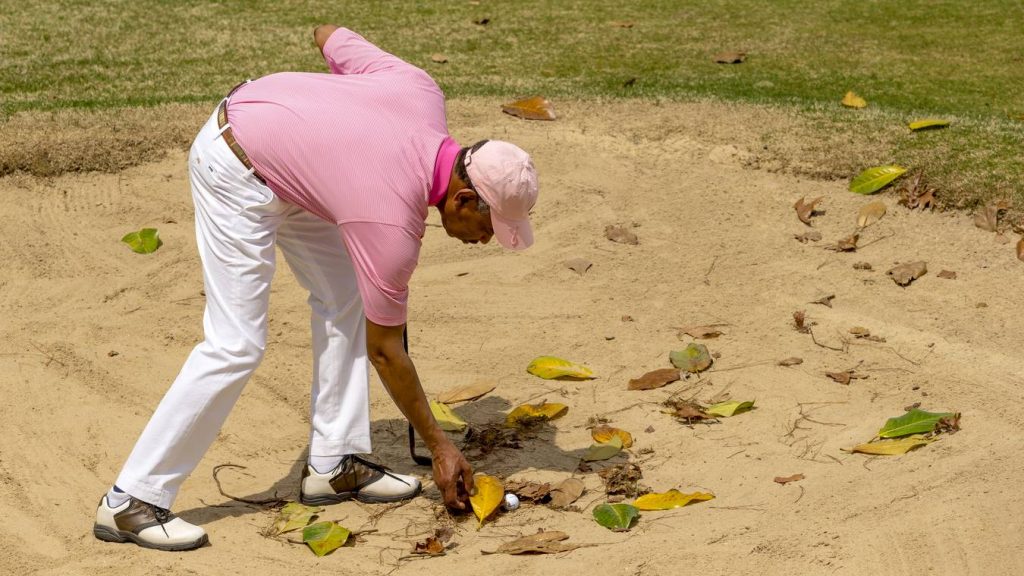Around the Green
The latest golf-related news, notes, and feature stories from the TGA.
Winter Golf and Loose Impediments

One of the many great things about Texas is our year-round golf season. It might mean an extra layer or two of clothing, but plenty of Texans already are playing golf and posting scores. And, while playing this time of year can be wonderful, it does lead to some extra challenges we don’t face in the summer. If you play this weekend, you’ll probably encounter more objects on the ground than usual, such as fallen leaves and branches. These and other natural objects are classified by the Rules as loose impediments. Luckily, you can move loose impediments out of your way without penalty.
By definition, loose impediments are unattached natural objects like stones, loose grass, leaves, branches, pine needles, clumps of compacted soil (including aeration plugs), etc. Dead animals, worms, insects and other similar life forms that can be removed easily, and the mounds or webs they build (such as worm casts and ant hills), are also loose impediments.
However, and be careful here, such natural objects are not “loose” if they are attached or growing, solidly embedded in the ground (that is, cannot be picked out easily) or sticking to the ball. Those are not loose impediments.
Neither is loose soil, sand, dew, frost and/or water. Snow and natural ice (other than frost) are either loose impediments (meaning they can be moved) or, when on the ground, temporary water (meaning free relief is available), at your option. While sand and loose soil are not loose impediments by definition, you may remove them on the putting green.
With the new Rules that were implemented in 2019, players now are able to remove loose impediments that lie anywhere on the course without penalty, see Rule 15.1a. There previously were restrictions against moving them in a penalty area, but you may now move loose impediments that lie in any area of the course, including in a bunker or a penalty area.
While you may remove loose impediments anywhere, you should take care to not move your ball in doing so. If the removal of a loose impediment causes your ball to move, you must replace the ball on its original spot and you usually get a one-stroke penalty, see Rule 15.1b. There are exceptions to the Rule though. When your ball lies on the putting green, there is no penalty if you accidentally cause it to move when removing a loose impediment. Also, you can remove loose impediments by any means! Go ahead and use your towel or hat to remove any such items that may be in your way.
Another common question related to loose impediments is what happens if your ball deflects off a loose impediment while it’s in motion? If your ball in motion hits a loose impediment, you must play it as it lies with no penalty. This applies whether the loose impediment is moving or at rest and whether your ball is on the putting green or elsewhere.
Abnormal Conditions
In addition to loose impediments being more pervasive in the winter, it’s also the time of year when many courses undergo various maintenance projects, so you may encounter some abnormal conditions on the course.
The offseason often is a time when clubs schedule regular maintenance, such as aeration or course improvement projects. Let’s take a look at how these practices might affect play on the golf course. Any hole made by the Committee or the maintenance staff in maintaining the course (such as a hole made in removing turf or a tree stump, or laying pipelines) as well as grass cuttings, leaves and any other material piled for later removal are deemed ground under repair by definition. Therefore, you are automatically entitled to free relief, see Rule 16.1.
A Committee may also wish to define certain areas as ground under repair because of course conditions. If the Committee clarifies that an area is treated as ground under repair, you may also take free relief provided your ball does not lie in a penalty area.
Aeration holes do not fall within the meaning of a hole made by the maintenance staff, and thus are not ground under repair. Therefore, you may not repair them on the putting green (or anywhere on the golf course) or automatically take free relief from them in the general area. As such, holes can interfere with the proper playing of the game, a Committee may choose to use a Local Rule to give relief from these holes (Model Local Rule E-4). If this Local Rule is in effect, you may take free relief when your ball lies in or touches an aeration hole.
When playing golf at this time of year, or really at any time of year, there is always a chance that you will encounter loose impediments or abnormal conditions on the golf course. Hopefully you now have a better understanding of how to proceed in these situations under the new 2019 Rules of Golf. Continue to enjoy golf in the New Year!
For more on the Rules, click here.



